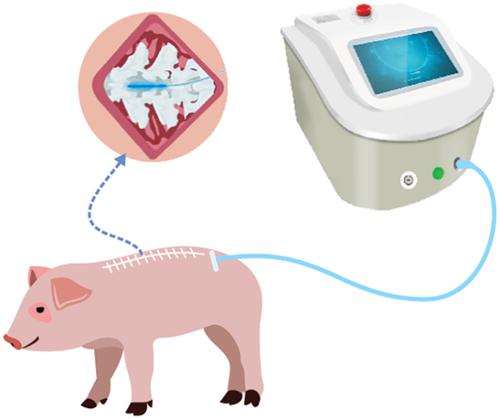当前位置:
X-MOL 学术
›
J. Biophotonics
›
论文详情
Our official English website, www.x-mol.net, welcomes your
feedback! (Note: you will need to create a separate account there.)
Photobiomodulation by diffusing optical fiber on spinal cord: A feasibility study in piglet model.
Journal of Biophotonics ( IF 2.0 ) Pub Date : 2020-01-14 , DOI: 10.1002/jbio.201960022 Zhuowen Liang 1 , Tao Lei 2 , Shuang Wang 3 , Xiaoshuang Zuo 1 , Kun Li 1 , Jiwei Song 1 , Jiakai Sun 1 , Jiawei Zhang 1 , Qiao Zheng 1 , Xiaowei Kang 4 , Yangguang Ma 1 , Xueyu Hu 1 , Tan Ding 1 , Zhe Wang 1
Journal of Biophotonics ( IF 2.0 ) Pub Date : 2020-01-14 , DOI: 10.1002/jbio.201960022 Zhuowen Liang 1 , Tao Lei 2 , Shuang Wang 3 , Xiaoshuang Zuo 1 , Kun Li 1 , Jiwei Song 1 , Jiakai Sun 1 , Jiawei Zhang 1 , Qiao Zheng 1 , Xiaowei Kang 4 , Yangguang Ma 1 , Xueyu Hu 1 , Tan Ding 1 , Zhe Wang 1
Affiliation

|
Previous studies on spinal cord injury (SCI) have confirmed that percutaneous photobiomodulation (PBM) therapy can ameliorate immunoinflammatory responses at sites of injury, accelerate nerve regeneration, suppress glial scar formation and promote the subsequent recovery of locomotor function. The current study was performed to evaluate a large‐animal model employing implanted optical fibers to accurately irradiate targeted spinal segments. The method's feasibility and irradiation parameters that do not cause phototoxic reaction were determined, and the methodology of irradiating the spinal cord with near‐infrared light was investigated in detail. A diffusing optical fiber was implanted above the T9 spinal cord of Bama miniature pigs and used to transfer near‐infrared light (810 nm) onto the spinal cord surface. After daily irradiation with 200, 300, 500 or 1000 mW for 14 days, both sides of the irradiated area of the spinal cord were assessed for temperature changes. The condition of the spinal cord and the position of optical fiber were investigated by magnetic resonance imaging (MRI), and different parameters indicating temperature increases or phototoxicity were measured on the normal spinal cord surface due to light irradiation (ie, heat shock responses, inflammatory reactions and neuronal apoptosis), and the animals' lower‐limb neurological function and gait were assessed during the irradiation process. The implanted device was stable inside the freely moving animals, and light energy could be directly projected onto the spinal cord surface. The screening of different irradiation parameters preliminary showed that direct irradiation onto the spinal cord surface at 200 and 300 mW did not significantly increase the temperature, stress responses, inflammatory reactions and neural apoptosis, whereas irradiation at 500 mW slightly increased these parameters, and irradiation at 1000 mW induced a significant temperature increase, heat shock, inflammation and apoptosis responses. HE staining of spinal cord tissue sections did not reveal any significant structural changes of the tissues compared to the control group, and the neurological function and gait of all irradiated animals were normal. In this study, we established an in‐vivo optical fiber implantation method, which might be safe and stable and could be used to directly project light energy onto the spinal cord surface. This study might provide a new perspective for clinical applications of PBM in acute SCI.
中文翻译:

通过在脊髓上扩散光纤进行光生物调节:在仔猪模型中的可行性研究。
先前对脊髓损伤(SCI)的研究已经证实,经皮光生物调节(PBM)治疗可以改善损伤部位的免疫炎症反应,加速神经再生,抑制神经胶质瘢痕形成并促进随后的运动功能恢复。当前的研究是对使用植入的光纤准确照射目标脊柱节段的大动物模型进行评估。确定了该方法的可行性和不引起光毒反应的辐照参数,并详细研究了用近红外光辐照脊髓的方法。将扩散光纤植入巴马小型猪的T9脊髓上方,用于将近红外光(810 nm)传输到脊髓表面。在每天以200、300、500或1000 mW照射14天后,评估脊髓照射区域的两侧温度变化。通过磁共振成像(MRI)研究脊髓的状况和光纤的位置,并测量正常的脊髓表面由于光照射而引起的温度升高或光毒性的不同参数(即热休克反应,炎症在辐照过程中评估了动物的下肢神经功能和步态。植入的装置在自由移动的动物体内是稳定的,并且光能可以直接投射到脊髓表面。初步筛选不同的辐照参数表明,在200和300 mW的直接照射到脊髓表面不会显着增加温度,应激反应,炎症反应和神经细胞凋亡,而在500 mW的辐照会稍微增加这些参数,而在500 mW的辐照1000 mW引起明显的温度升高,热休克,炎症和细胞凋亡反应。与对照组相比,脊髓组织切片的HE染色未显示任何明显的组织结构变化,并且所有受辐照动物的神经功能和步态均正常。在这项研究中,我们建立了一种体内光纤植入方法,该方法可能安全且稳定,可用于将光能直接投射到脊髓表面。
更新日期:2020-01-14

中文翻译:

通过在脊髓上扩散光纤进行光生物调节:在仔猪模型中的可行性研究。
先前对脊髓损伤(SCI)的研究已经证实,经皮光生物调节(PBM)治疗可以改善损伤部位的免疫炎症反应,加速神经再生,抑制神经胶质瘢痕形成并促进随后的运动功能恢复。当前的研究是对使用植入的光纤准确照射目标脊柱节段的大动物模型进行评估。确定了该方法的可行性和不引起光毒反应的辐照参数,并详细研究了用近红外光辐照脊髓的方法。将扩散光纤植入巴马小型猪的T9脊髓上方,用于将近红外光(810 nm)传输到脊髓表面。在每天以200、300、500或1000 mW照射14天后,评估脊髓照射区域的两侧温度变化。通过磁共振成像(MRI)研究脊髓的状况和光纤的位置,并测量正常的脊髓表面由于光照射而引起的温度升高或光毒性的不同参数(即热休克反应,炎症在辐照过程中评估了动物的下肢神经功能和步态。植入的装置在自由移动的动物体内是稳定的,并且光能可以直接投射到脊髓表面。初步筛选不同的辐照参数表明,在200和300 mW的直接照射到脊髓表面不会显着增加温度,应激反应,炎症反应和神经细胞凋亡,而在500 mW的辐照会稍微增加这些参数,而在500 mW的辐照1000 mW引起明显的温度升高,热休克,炎症和细胞凋亡反应。与对照组相比,脊髓组织切片的HE染色未显示任何明显的组织结构变化,并且所有受辐照动物的神经功能和步态均正常。在这项研究中,我们建立了一种体内光纤植入方法,该方法可能安全且稳定,可用于将光能直接投射到脊髓表面。












































 京公网安备 11010802027423号
京公网安备 11010802027423号